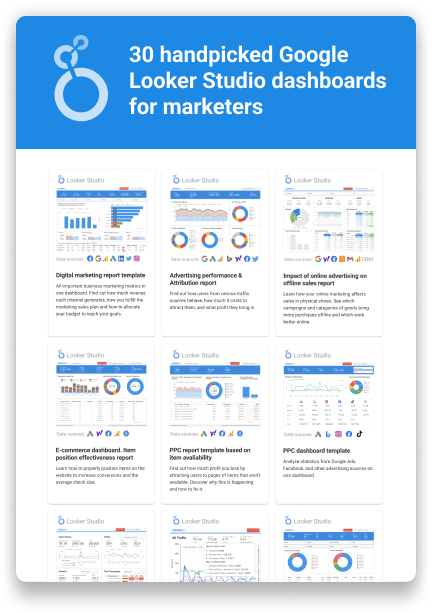Table of contents
How to Use Marketing Mix Modeling to Increase ROI
Ievgen Krasovytskyi, Head of Marketing @ OWOX
Liubov Zhovtonizhko, Creative Writer @ OWOX
Marketing Mix Modeling. MMM. Are you navigating the world of digital marketing and wondering how to optimize your strategies? Your performance?

In this article, updated in January 2024 we're diving into what Marketing Mix Modeling is, what the top 3 use cases are, and why you should use the MMM approach for your business. With this being said, Let’s dive right in!
What is Marketing Mix Modeling?
Marketing Mix Modeling (or MMM) is a data-driven method of statistical analysis that uses both sales and marketing data to estimate the impact of internal and external marketing activities on sales. Marketers use MMM to measure marketing effectiveness and predict the impact of future efforts — most often on the ad spend and generated revenue.
In a current multi-channel marketing approach, businesses are using search ads, paid social media ads, display ads, PR activities, billboards, organic Instagram, facebook or X activities, webinars, email marketing, affiliate programs, promotions, and so much more.
Plus, those marketing channels can make their own thing at the different stages of your hero’s journey.
For example, your Facebook ad may be focused on building brand awareness,
email marketing - to nurture leads,
while bottom-of-the-funnel tactics may include search ads to get more sales or close more deals.
While lots of different channels and tactics can help you achieve multiple goals and reach a larger audience, they can also mess things up.
Nowadays, there are a lot of things to track:
- Advertising channels, Website activities,
- Mobile applications,
- Email activity,
- Sales in your crm tool.
And as you add different channels to your stack, you will quickly find it more difficult to determine which of those channels are contributing the most to your goals. That's where advanced analytics tactics like MMM can help you out.
Elements of Marketing Mix Model
Basic 4P model
The marketing mix model consists of four main elements: Product, Price, Place (distribution channels), and Promotion..
Each of these elements answers a specific question.
- Product: What is needed by the market and target audience?
- Price: What should the product cost?
- Place: What is the optimal distribution model to deliver the product to the customer?
- Promotion: How will information about the company’s products be distributed in the market?
Modern model
Since the 4P marketing mix model was first introduced in 1960 by Edmund Jerome McCarthy, marketers have complemented it to fit the modern market.
Trying to update and improve it there's been a fifth element added – People, as well as 6th and 7th: Process and Physical evidence may be considered more or less successful.
Updated marketing mix models:
- 5P model: 4P + People. Answers the question, How should your employees be perceived by customers?
- 7P model: 5P + Process + Physical evidence. The Process element answers the question, How can we optimize the process of creating and delivering the product to customers? The Physical evidence element answers the question, How can the appearance of your store influence the buyer’s decision?
Use Cases of Marketing Mix Modeling
With Marketing Mix Modeling, marketers can gain a holistic view of results of your marketing efforts. With that wider, larger, more helicopter view, they can better determine where to allocate resources right now. Be it a new ad campaign, another channel or improving email copy...
Useful, right? Here are the top 3 of the most common use cases of how you can benefit from an MMM.
- Performance analysis
- Predictive Modeling
- And Pricing Strategy
Use Case #1: Performance Analysis
Performance Analysis. It's all about getting the most bang for your marketing buck.
Imagine you're sitting in front of your all-in-one performance dashboard.
You've got all of your channels – Google Ads, Facebook campaigns, email marketing, and maybe even some old-school billboards.
Each channel is consuming part of your budget, but which one is really bringing in the gold?
You should look at which sales amounts were attributed by your rules to each campaign.
You're not just looking at surface-level data; you're digging deep to find out if your investment in a particular campaign or channel is truly worth it.
Let’s say your social media ads are creating a buzz, but are they leading to sales? Or is it the email marketing that’s slowly converting subscribers into customers? MMM helps you collect this puzzle, uncovering which channels are the true heroes of your sales story at the funnel stage they’re created for.
At the end of the day, you can allocate your budget more wisely.
You start to invest more in channels that work at the overall level and cut back on those that don't.
It’s about being smart with your spending and efforts, ensuring every dollar contributes to your overall business goals.
And the best part? This is not a one-time deal. MMM is dynamic.
As the market changes, and as consumer behavior shifts, MMM keeps adapting, providing you with ongoing insights for continuous improvement. It’s about staying agile and making data-driven decisions that keep you ahead of the curve.


Use Case #2. Forecasting and Predictive Modeling
Predictive Modeling takes your marketing analysis to a whole new level. It's about using historical data to make informed guesses about the future, helping you better navigate the uncertainty.
Think of Predictive Modeling as your GPS. It helps you chart the best route for your campaigns based on the roads you've traveled before and the traffic right now. You're using past performance to predict future revenue.
For example, your past campaigns show a trend: increased social media ad spending leads to higher engagement, which correlates with spikes in sales.
With Predictive Modeling, you can use this insight to forecast the potential success of ramping up your social media budget in the upcoming quarter… and when exactly.
It's like having a forecast that guides your budget allocation, campaign planning, and strategy development.
But please note that predictive modeling isn’t about exact predictions. But it gives you a more informed starting point for your decisions. It's a blend of art and science – where data meets strategy. And in a world where marketing needs to be agile and data-driven, that’s a powerful combination.
Use Case #3: Product Pricing Strategy
If you want to improve not only the sales, but also optimize the strategies for profitability it’s important to see how MMM can help you adjust the Pricing Strategy.
MMM in pricing is a crystal ball. You’re not just guessing the best price for the specific product; but you’re using a combination of historical sales data, market trends, and consumer behaviors to find the sweet spot.
Let’s say you have a range of products. MMM helps you analyze how different pricing strategies have impacted sales in the past. It looks at how price changes affect demand, competitors’ pricing strategies, and market conditions.
Imagine you’re considering a price hike for a best-selling product.
With MMM, you can predict how this might affect the sales volumes. Will the increased price deter customers, or is the perceived value of the product high enough to sustain the increase?
MMM helps you strike a balance between profit margins and sales volumes. It guides you on when it’s going to be the most beneficial to offer discounts, how to bundle products, or if a premium pricing strategy would work.
In essence, MMM turns product pricing adjustment into a strategic opportunity, empowering you to make decisions that not only maximize revenue but also align with your brand positioning and market dynamics.
Why should you implement MMM in 2024
But why should you really implement it In 2024, and what are the changes that happened recently?
The world of marketing has never been so complex. Different advertising and placements, that we as marketers can leverage to get the right message out at the right time at the right place….
Some of those tools are easily trackable, but some are not at all.
Plus, some of those platforms attribute more conversions to themselves than they deserve. Why? Privacy…
Traditional pixel-based tracking methods became less effective due to the current privacy regulations…
A significant proportion of traffic comes from unknown sources…
This happens, because of the limited lifespan of cookies in a browser, which leads to losing the connection between website conversions and user sessions from the original traffic source.
As a result, marketers had to act blindly when allocating ad budgets and missing on the growth opportunities.
Another problem is that non-consent data doesn’t have session traffic sources even for converted visitors…
If you want to learn more about how to overcome these traditional tracking limitations - check the guide below:
Uncover in-depth insights
Server-Side Tracking: Monitoring User Behavior Without Pixels
Download nowBonus for readers

This all means that marketers need a way to evaluate so many tactics, limitations, and, finally, data to find what exactly is the most valuable for getting sales.
Marketing Mix Modeling, when performed correctly, provides a sophisticated approach to understanding the complex interplay of marketing channels and strategies.
And the data is used for MMM should be first of all, accurate, trusted and reliable.
Do you want to make budget allocation decisions, based on the data you don’t trust?
How to implement Marketing Mix Modeling
Let's turn to the technical part of this article. Working with the marketing mix model consists of three stages:
- Pre-planning stage. This stage includes analysis of historical data such as sales, expenses for all past advertising campaigns, and ROI. With OWOX BI Pipeline, you can automatically collect ad campaign cost data as well as the sales data from your CRM.
Automate your digital marketing reporting
Manage and analyze all your data in one place! Access fresh & reliable data with OWOX BI — an all-in-one reporting and analytics tool
4.9
- Planning stage. This stage consists of predicting and evaluating the effectiveness of marketing efforts. At this stage, the marketing mix model helps you predict sales and conversions across advertising campaigns and allows you to properly allocate your budget to optimize ROI.
- Results tracking stage. This stage involves tracking the effectiveness of all marketing variables, modeling spending scenarios and, if necessary, adjusting marketing activities.
Important to remember: Since the marketing mix model uses historical data to evaluate marketing effectiveness, it’s not an effective tool for analyzing new products. The relatively short history of new products makes the results of the marketing mix uncertain.
The marketing mix model uses a regression method for studying the effect of one or more independent variables on a dependent variable. Independent variables are otherwise called regressors or predictors, and dependent variables are also called criterion variables. The analysis performed using this model is then used to extract key information and new marketing ideas.
So the dependent variable can be sales or market share. The most commonly used independent variables are price, TV costs, outdoor campaign costs, advertising costs, and website visitors.
An equation is formed between dependent variables and predictors (independent variables). The beta generated from regression analysis quantifies the impact of each marketing channel. Essentially, the beta shows that increasing the input value by one unit will increase sales / profits by beta units, assuming that other marketing resources are constant.

After assigning the variables, several iterations are performed to create a model that accurately explains the volume and cost trends. Further checks are then performed using either validation data or a sequence of business results.
In the marketing mix model, sales are divided into two types:
- Base sales occur when there’s no advertising for a product. These sales come purely from the brand image that’s been created over the years. Base sales are usually fixed, unless there are some changes in economic or environmental factors.
- Gradual sales are generated by marketing activities such as television advertising, print advertising, digital spending, and advertising campaigns. The total number of gradual sales will be divided into sales for each resource to calculate the marketing contribution to total sales.
Important to remember: The relationship between marketing and sales can be radically different during startup and stable periods. For example, the initial sales of Coke Zero were very poor, and reports showed ineffective advertising. Despite this, the Coca-Cola company increased their spending on media and has raised the effectiveness of their advertising several times since the launch. A typical marketing mix model would recommend reducing media costs and instead increasing the price of a product. Therefore, you need to take into account all the factors of your current situation.
Key Takeaways
The marketing mix model helps you understand how your marketing affects sales. It also helps you determine the most effective advertising channels, predict the results of your current marketing decisions, and optimize your marketing budget.
However, while MMM offers numerous benefits, it's not without challenges.
Implementing MMM on your own requires a deep understanding of nitty-gritty details of data collection, marketing analytics, coding, and more... It often requires collaboration between the teams to ensure seamless flow.
If you need help implementing the MMM or building the machine learning full-funnel attribution, OWOX BI and our team of analytics experts are here to make your day. Just follow the link in the description, book a call with a member of our team and we’ll find the right analytics stack for your needs.

Gain clarity for better decisions without chaos
No switching between platforms. Get the reports you need to focus on campaign optimization
FAQ
-
What is market mix modeling?
Market mix modeling is a statistical and analytical technique used to quantify the impact of marketing activities on sales and identify the most effective marketing strategies. It involves analyzing various marketing variables, such as advertising spend, promotions, pricing, and distribution, to determine their influence on consumer behavior and overall business performance. -
How does market mix modeling work?
Market mix modeling works by collecting historical data on marketing variables and sales, then using statistical techniques to evaluate the relationships between these variables. It identifies patterns, trends, and correlations to determine the individual impact of each marketing element in driving sales. By analyzing these factors, companies can optimize their marketing efforts and allocate resources effectively to maximize return on investment. -
What are the benefits of using market mix modeling?
Market mix modeling offers several benefits for businesses. It helps in understanding the effectiveness of different marketing activities and channels, enabling companies to make data-driven decisions. By identifying the best combination of marketing strategies, it allows businesses to optimize their marketing budgets and allocate resources to activities that generate the highest ROI. Market mix modeling also provides insights into customer behavior and preferences, enabling companies to tailor their marketing efforts accordingly.













